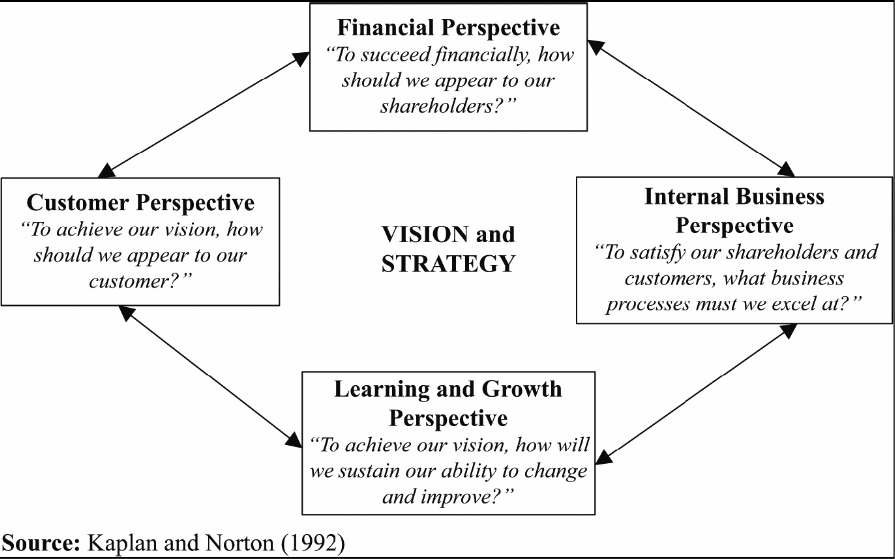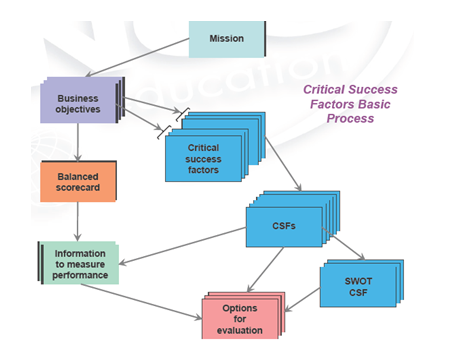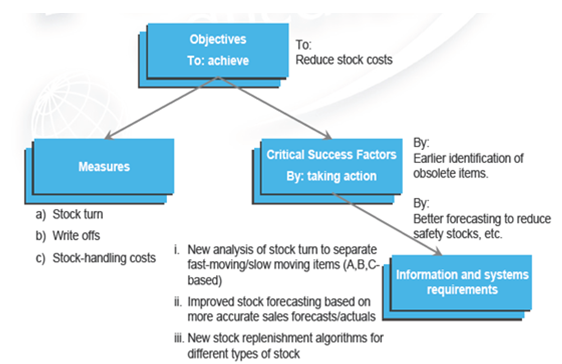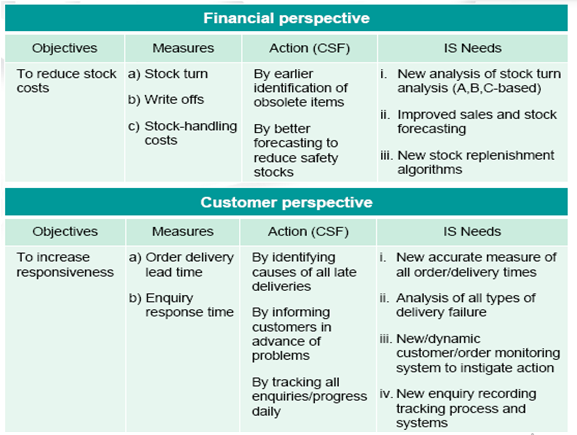Introduction
Over the past years, a rapid increase in global competition brought about by technological change and product variety has created the need for continuous performance improvement as a strategic and competitive requirement in many organizations world wide.
In order for organizations to maintain and improve their competitive advantages, performance measures are widely used to evaluate, control and improve business processes. However, recent studies indicate that traditional performance measures that once sufficed and no longer able to provide the desired results. As a result, other approaches to measuring performance are necessary.
Among others, the balanced scorecard has been used widely by many organizations to measure the performance of information systems and to provide a means of assessing how best they can be used strategically to gain a competitive advantage (Cannon 12). The balanced scorecard, developed by Kaplan and Norton, is a framework for the communication and implementation of strategy (Kettunen & Kantola 263).
It provides managers with a means to navigate to future competitive success (Kaplan & Norton 2). It is also regarded as a performance measurement system that translates an organization’s mission and strategy into a set of performance measures with a view to providing a comprehensive and balanced framework for strategic measurement and management (Kamhawi 475).
In the present business environments, industrial age competition has been replaced by the information age competition. While the adoption of technology really mattered during the industrial age completion, this is no longer the case when it comes to the information age era.
It is now obvious that companies can not gain sustainable competitive advantage by simply deploying new technology into physical assets rapidly by excellent management of financial assets and liabilities like they did during the industrial age (Kaplan & Norton 3).
Therefore, considering that organizations today are competing in very complex business environments, an accurate understanding of their goals as well as the methods for attaining the goals is very critical.
This paper looks at how an organization may use the balanced scorecard approach in information systems setting to gain a competitive advantage. It also provides measures that may be used to the benefit of using the scorecard.
Perspectives of the Balanced Scorecard
Although the balanced scorecard places greater emphasis on the achievement of financial objectives, it also includes the performance drivers of the financial objectives and measures organizational performance across four balanced perspectives: financial, customers, internal business processes, learning and growth.
Subsequently, it the balanced scorecard enables companies to track financial results while simultaneously monitoring progress in building the capabilities and acquiring the intangible assets needed for future growth (Kaplan & Norton 2). Typical examples observed in companies that have adopted the balanced scorecard approach include the following (Kamhawi 476):
- Financial – puts emphasis on shareholder satisfaction, key goals and measures here generally involve gross and/or net profitability, return on capital employed, residual income, economic value added, sales growth, market position and share, and cash flow among others.
- Customer – the focus here is more on the external customer satisfaction. Key goals and indicators in this perspective typically stress common customer concerns such as delivery time, quality, service and cost.
- Internal business – The key goals and measures should highlight critical skills and competencies that are required, processes and technologies that will deliver current and future organizational success.
- Learning and growth – underpinning the other three perspectives, the key long-term goals and indicators in this regard typically relate to improving flexibility and investing for future development and new opportunities.
There are also important relationships that are present between the four perspectives with innovation and learning being the driving force to deliver success in the internal business processes, which then in turn will meet customer and consequently, shareholder needs. Figure 1 shows the four components of the balanced scorecard and how they are related.

Figure 1: Balanced Scorecard with Four related Perspectives (Kamhawi 476)
The Balanced Scorecard Applied to IS
According to Pearlson and Saunders (84), the application of the different categories of the balanced scorecard to information systems requires a much broader interpretation. With this approach, for example, a customer is a user within an organization and not an external customer.
Cannon (64) argues that although the balanced scorecard methodology is common outside the information systems environment, information systems can greatly benefit from applying it if it implemented by the Chief Executive Officer (CEO). This suggests an inclusive approach to the implementation of the balanced scored technique.
While some organizations have been successful in using the balanced scorecard approach, many have terribly failed. The failure has been largely linked to the fact the implementations are run by people in the organization other than the Chief Executive Officer (Cannon 64). This is mainly because the top leadership sets the agenda that must be followed by all within the organization.
From this argument, it follows that a scorecard used within the IT department will senior IS managers understand their organization’s performance, and measure it in a way that supports its business strategy. The information system scorecard is linked to the business scorecard, by making sure that the measures that are used by information systems are those that support the organizations business goals (Pearlson & Saunders 84).
Generating Measures for Information Systems
Table 1 gives an illustration of how the balanced scorecard approach may be used to generate performance metrics for an information system.
Table 1: Balanced Scorecard applied to an Information System department
As can be seen from figure 1, the balanced scorecard technique is not self sustaining. It only conveys goals and measures of success. There exists no formal statement of the actions needed to reach the identified goals. To overcome this problem, a set of critical success factors (CSFs) and the required information to reach each goal are attached to it.
Critical success factors are considered to be activity areas that must be receive constant and careful attention from management. The current status of performance in each of these areas should be continually measured, and that resultant information should be made widely available (Pearlson & Saunders 87).
According to Cannon (69), CSFs should be determined only when the business objectives have clearly been identified. Critical success factors are then identified against each objective and a prioritization of the achievement of the critical success factors is then provided depending on the number of objectives sharing the critical success factor.
Later, the importance of information to the achievement of the objectives is considered. Finally, a Strengths, Weaknesses, Opportunities and Threats analysis of an information system is generated. It is advisable to have each objective associate with a reasonable number of critical success factors. Figure 2 shows how the critical success factors are integrated into the balanced scorecard.

Figure 2: Integrating Critical Success Factors into the Balanced Scorecard (Pearlson & Saunders 87)
Consolidating the Balanced Scorecard and Critical Success Factors Analysis
A comprehensive set of IS requirements may therefore, be obtained by combining the output of the balanced scorecard and the critical success factors. The balanced scorecard links measures to business objectives while the critical success factors analysis identifies what is critical to achieving the intended results.
The combination of these techniques makes it possible to achieve a thorough assessment of prioritized IS opportunities. Table 2 shows an example of how the balanced scorecard analysis approach may be used to derive improvements to information system operational activities and to identify both internal and external information requirements for the activities.
Table 2: Application of the Balanced Scorecard Analysis
From the analysis of the balanced scorecard, each of the identified objectives is then subjected to a critical success factor analysis.
From the analysis of figure 4, the information and systems requirements that will support the critical success factors include; a new analysis of stock-turn to separate fast-moving and slow-moving items, an improved stock forecasting based on more accurate sales forecast against the actual and a new stock replacement algorithm for different stock types.
However, it is important to note that the decision about which system should be developed largely depends upon the organization’s business priorities.
Figure 3 shows how both the balanced scorecard and the critical success factors analysis may be used for strategic reasons to address an organization’s information system requirements while figure 4 gives a clear indication of the outputs of the balanced scorecard and the critical success factors analysis.

Figure 3: Using the Balanced Scorecard and Critical Success Factors Analysis for strategic reasons

Figure 4: Outputs of the Balanced Scorecard and the CSF Analysis
Conclusion
The balanced scorecard creates strategic awareness among the members of the organization and aligns the strategies of different administrative units. It helps to create a shared understanding about the efforts and steps needed for change.
The balanced scorecard translates the strategy into tangible objectives and measures. The experiences of this study testify to the applicability of the balanced scorecard as a basis for a campus-wide management information system (Kettunen & Kantola 272).
When properly implemented, the balanced scorecard concept enforces better alignment by defining the details of strategic business objectives. Using the scorecard is meant to eliminate activities that are of little or no strategic value (Cannon 64).
The use of the balanced scorecard can be continuously monitored openly by everyone in the organization. The trends and development of operations can be monitored and evaluated in order to make necessary changes to achieve the desired strategic objectives of the business (Kettunen & Kantola 273).
As organizations endeavor to implement the balanced scorecard for information systems, it is important to note as earlier pointed out, that on its own, the balanced score card can not deliver the intended results. It critical to look at other factors that are key contributors to ensure the scorecard works as intended.
Some of the critical factors that must be considered include; the need to ensure that the implementation has total support from the organizations’ top management and that it also receives support from other available approaches to measuring performance.
Usually, it is important to assign the custody of the balanced scorecard to a person within the organization who will be solely in-charge of making sure that it works to the benefit of the organization. For most organizations, the custody of the balanced scorecard is left with the finance function mainly because of its place at the center of the organization’s information processing and distribution.
Works Cited
Cannon, David L. CISA Certified Information Systems Auditor Study Guide. Hoboken, NJ: John Wiley & Sons, Inc., 2011.
Kamhawi, Emad M. IT and non-IT factors influencing the adoption of BSC systems: a Delphi study from Bahrain. International Journal of Productivity and Performance Management, 60 (5) 474 – 492. 2011.
Kaplan, Robert S. & Norton, David P. The Balanced Scorecard: Translating Strategy into Action. Boston, MA: Harvard Business Press, 1996. Print.
Kettunen, Juha & Kantola, Ismo. Management information system based on the balanced scorecard. Campus-Wide Information Systems, 22 (5) 263 – 274. 2005.
Pearlson, Keri & Saunders, Carol. Managing and Using Information Systems: A Strategic Approach. Hoboken, NJ: John Wiley & Sons, Inc., 2006. Print.